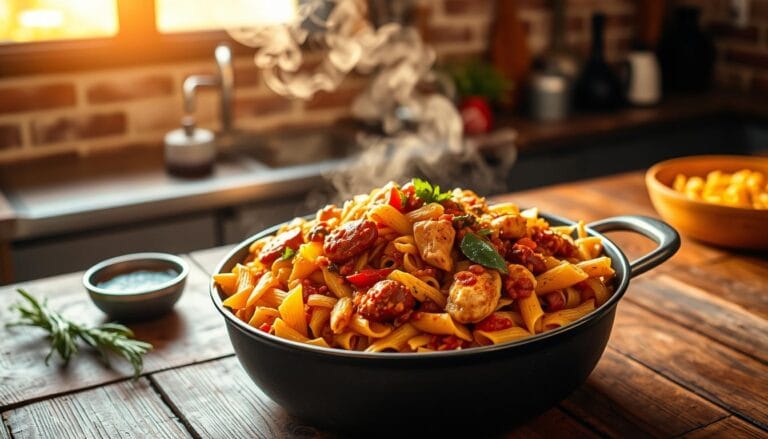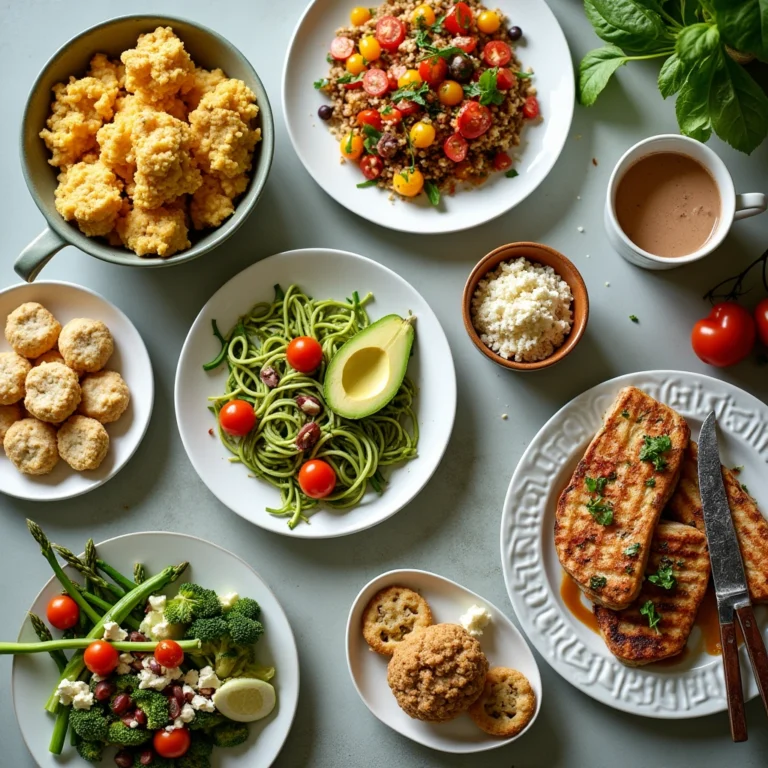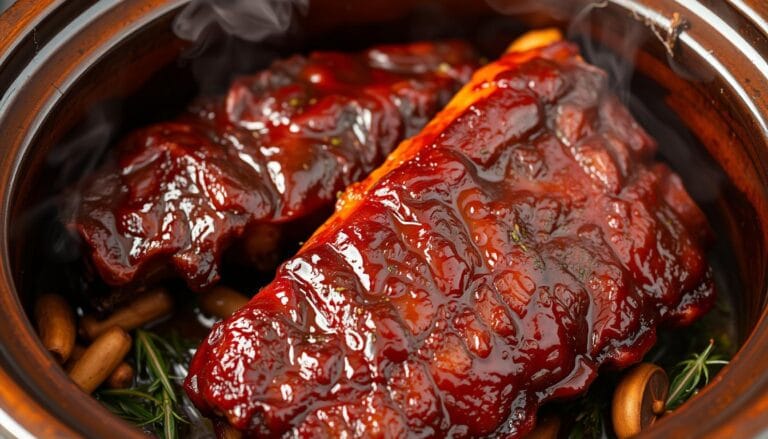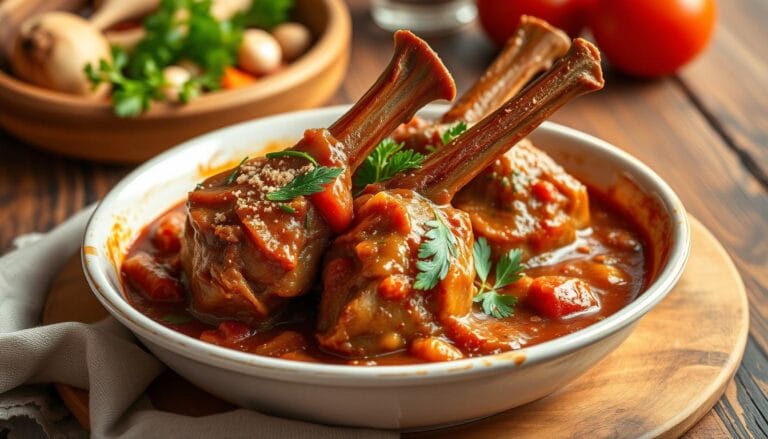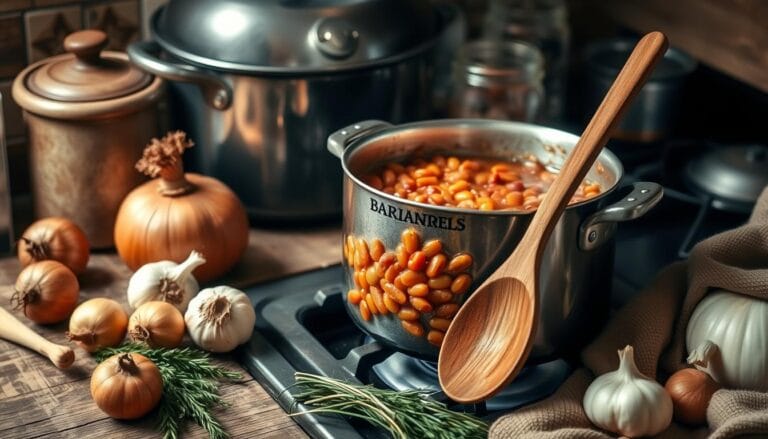Easy Homemade Beef Stew Seasoning Recipe
As a kid, the smell of my grandma’s beef stew was like coming home. She mixed her own spices by hand. Now, I’ve made my own version of that warmth.
This easy beef stew seasoning recipe lets you skip store-bought mixes. You’ll save money and create a flavor that’s all yours. It’s not just a mix; it’s a way to enjoy every bite of comfort food.
Table of Contents
Key Takeaways
- Uses common pantry spices for quick, no-fuss preparation.
- Cuts costs by replacing expensive store-bought seasoning blends.
- Customizable to match dietary needs or taste preferences.
- No hidden additives—only pure, fresh ingredients.
- Perfect for classic beef dishes or inventive protein swaps.
Why Make Your Own Beef Stew Seasoning
Homemade beef stew seasonings have many benefits over store-bought packets. I found that making my own spices for stew brings out richer flavors. It also saves money and gives me peace of mind.

Cost Benefits of Homemade Seasonings
A single-use seasoning packet costs about $0.75. But my homemade blend is a different story. One batch of beef stew seasonings makes 10 meals for just $2.50. Here’s how it breaks down:
| Option | Cost Per Serving |
|---|---|
| Store-bought packets | $0.75 |
| Homemade blend | $0.25 |
Control Over Ingredients and Flavors
With my own spices for stew, I can adjust the flavors to my liking. For instance:
- Add extra garlic powder for depth
- Cut back on salt for a low-sodium diet
- Swap cumin for caraway seeds
Avoiding Preservatives and Additives
Commercial mixes often include:
- MSG
- Anti-caking agents
- Artificial dyes
My blend, on the other hand, uses only whole beef stew seasonings like black pepper, oregano, and bay leaves. No hidden ingredients, just pure flavor.
Essential Ingredients for the Perfect Beef Stew Seasoning
Creating the best spices for beef stew is all about finding the right mix. I’ve tried many stew meat seasoning blends. The key is to balance core ingredients with what you like. Here’s how to get it just right.

Base Spices Every Stew Needs
These four spices are the heart of any stew:
| Spice | Description | Role |
|---|---|---|
| Paprika | Sweet or smoky | Foundation of color and depth |
| Black Pepper | Pungent | Earthy warmth |
| Garlic Powder | Concentrated | Umami boost without raw garlic |
| Thyme | Herbaceous | Earthy balance |
Optional Flavor Enhancers
- Rosemary: Adds piney freshness
- Bay Leaves: Subtle bitterness for complexity
- Mustard Powder: Tangy undertones
I use bay leaves carefully—just 1-2 for every ½ cup of base spices.
Salt Considerations
Kosher salt is better for stews because it dissolves well. For those watching their sodium, try using celery powder instead of salt. Always taste your mix before you’re done!
My Foolproof Beef Stew Seasoning Recipe
Here’s my go-to beef stew seasoning recipe that delivers deep, layered flavors every time. This blend uses 8 key spices measured precisely for balance:
- 2 tbsp sweet paprika (adds smokiness)
- 1.5 tbsp garlic powder (no raw garlic needed)
- 1 tbsp onion powder (for savory depth)
- 1 tsp dried thyme (earthy backbone)
- ¾ tsp black pepper (freshly ground works best)
- ½ tsp cayenne (adjust to taste)
- 1 bay leaf crushed (optional aroma boost)
- 1 tsp sea salt (added last for control)
Mix all dry ingredients in a glass bowl until no color streaks remain. The finished seasoning for beef stew should smell intensely herbal with a reddish-brown hue. Store in an airtight jar away from light.
“Avoid pre-ground spices older than 6 months—fresher spices make a noticeable difference.”
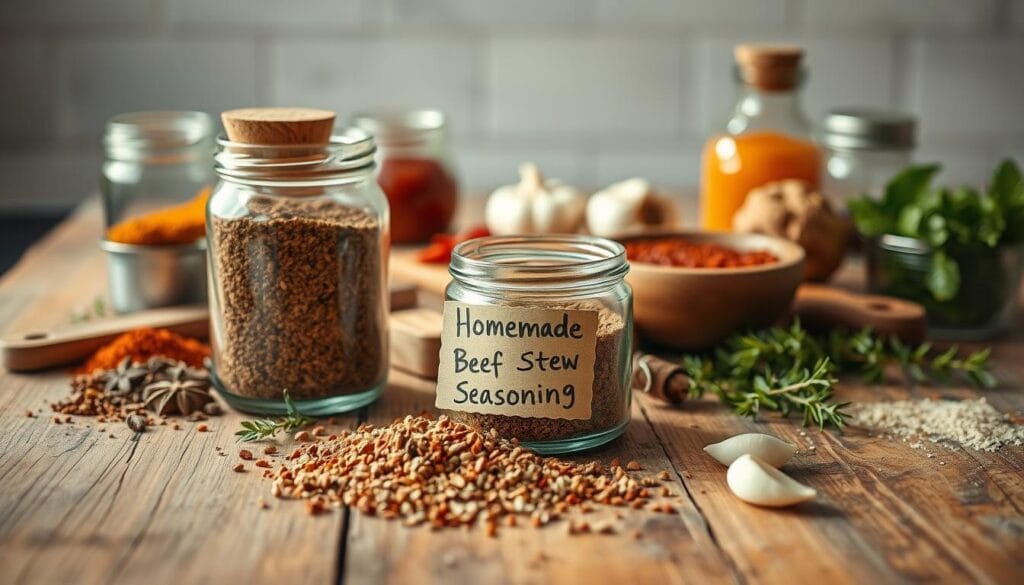
I recommend making ½ cup batches to keep flavors vibrant. For best results, sprinkle 2-3 tablespoons over cubed beef before browning, then add the remainder during stewing. Adjust cayenne gradually—start with ¼ tsp if you’re spice-sensitive.
Pro tip: Taste the dry blend before use. If one spice overpowers, balance with a pinch of sugar or extra thyme. This blend lasts 3 months when stored properly.
How to Customize Your Seasoning Blend
Creating your own beef stew seasonings lets you tailor flavors to your liking. Start with a basic recipe and then adjust the spices to fit your taste. Here’s how to make it your own:
Adjusting for Spice Preferences
Want it spicier? Add cayenne or red pepper flakes. For milder flavors, try sweet paprika instead of chili powder. Balancing with earthy cumin or smoky chipotle powder is a good idea. Remember, your blend should match your taste!
- Spicy kick: Add ¼ tsp cayenne per ¼ cup blend
- Herb-focused: Boost thyme and rosemary
- Umami depth: Increase soy sauce or mushroom powder
Regional Variations to Try
Try global twists with common spices for stew:
- French: Add thyme, bay leaves, and a dash of herbes de Provence
- Irish: Stir in caraway seeds and a pinch of juniper berries
- Southern: Use smoked paprika and a bay leaf
- Hungarian: Double the sweet paprika and add caraway
Making It Gluten-Free
Check spice labels for gluten. Look for brands like McCormick and Spice Barn that offer gluten-free options. Store these blends in separate jars. Use a clean spoon for each spice to avoid cross-contamination.
“Testing variations lets you discover your perfect blend.”
Small changes can make basic beef stew seasonings into your signature. Share your favorite tweaks in the comments below!
Best Techniques for Applying Stew Seasonings
Timing is key when using stew meat seasoning. Start by lightly seasoning raw beef before browning. This locks in flavor. I’ve found that adding half the spice blend at this stage adds depth without overpowering the dish.
The rest of the spices go into the liquid later. This lets the flavors meld as it simmers.
For consistent results, follow these guidelines:
- 1 tsp of best spices for beef stew per pound of meat when browning
- Add 1–2 tbsp of the full blend to the cooking liquid for 2–3 pounds of meat
- Bloom powdered spices in hot oil before adding liquid to heighten aroma
Browning beef first creates a flavorful base. Sprinkle your blend directly on meat before searing. Then, deglaze the pan with broth to capture fond. This layering prevents spices from burning.
Always taste as you go—over-seasoning at one stage leaves no room for adjustments later. For large batches, double-check measurements to maintain balance.
I once ruined a batch by adding cumin too early; now I wait until the stew simmers to preserve its earthy notes. Adjusting spice ratios based on cooking time ensures every bite of your stew shines with well-balanced flavors.
Pairing Your Seasoning with Different Meats
My beef stew seasonings are great for more than just beef. Let’s see how to use this mix on different proteins without losing flavor.
Traditional Beef Options
Begin with cuts like chuck roast or short ribs. For fatty cuts, use 1.5 tablespoons of seasoning per 2 lbs of meat. This balances the richness. Leaner cuts, like bottom round, need 2 tablespoons for even seasoning.
Always rub the seasoning onto the meat before browning. This ensures the flavors stick well.
Alternative Proteins That Work Well
Try these options with my blend:
- Lamb shanks: Use the same amount of seasoning but add red wine for extra depth.
- Venison: Cut the seasoning by 25% to not overpower the gamey taste.
- Plant-based proteins: Coat seitan or textured soy with 1.25 tablespoons per pound. Add olive oil before seasoning for better stickiness.
| Protein | Seasoning Adjustment | Tip |
|---|---|---|
| Bison | Full recipe amount | Simmer longer to tenderize |
| Mushrooms | 1.5 tablespoons | Sauté first to activate umami |
My family loves marinating tofu in the seasoning overnight. It makes a great vegan dish. Always taste and adjust as you go. Your taste buds are the best guide!
Storing Your Homemade Spice Blend
Keeping yourbeef stew seasoning recipefresh is key. Air, light, and moisture can harm the flavors of yourspices for stew. Here’s how to keep your blend fresh.
Proper Containers for Maximum Freshness
| Container Type | Pros | Cons |
|---|---|---|
| Glass jars | Non-reactive, transparent for visibility | Risk of breakage |
| Metal tins | Airtight seals, durable | May transfer metallic taste over time |
| Plastic containers | Lightweight and affordable | Can absorb odors |
Shelf Life and Storage Conditions
- Store in a cool, dark pantry to avoid heat exposure
- Seal containers tightly after each use
- Discard if spices clump or lose aroma
My blends last 3-6 months in airtight Ball jars. I label each jar with the mix date. I store them in a cabinet away from the stove. Always check for fading color or weak scent before use.
Proper storage keeps your homemadespices for stewfresh. Choose the right container and environment. Yourbeef stew seasoning recipewill always have bold flavor.
Beyond Stew: Other Uses for Your Beef Stew Seasoning
My stew meat seasoning blend isn’t just for stews. I’ve found many creative ways to use it in daily meals. Here are 10 surprising uses:
- Grill rub: Sprinkle on steak or chicken before grilling for bold flavor. Use 1 tsp per pound of meat.
- Burger magic: Mix 1 tbsp into ground beef for juicy, seasoned patties.
- Roasted veggies: Toss carrots or potatoes with oil and a pinch of seasoning before roasting.
- Meatloaf boost: Add 1-2 tsp to your meatloaf mixture for rich depth.
- Gravy enhancer: Stir a teaspoon into pan drippings when making gravy.
- Quick soup base: Add to broth with veggies for a fast, flavorful soup.
- Fancy fries: Sprinkle on air-fried or oven-baked fries.
- Popcorn twist: Mix into melted butter for a savory popcorn topping.
- Marinade: Combine with oil and soy sauce for a steak marinade.
- Omelet kick: Fold into scrambled eggs or omelets for a hearty breakfast.
“I first used my best spices for beef stew on roasted potatoes by accident—and now it’s my go-to veggie seasoning!”
This versatile blend saves time and spices up meals in unexpected ways. Start with small amounts and adjust to taste. It’s my secret ingredient in everything from breakfast to dinner!
Conclusion
Making your own beef stew seasoning opens up a world of flavors. You control what goes into it, save money, and avoid harmful additives. It lets you create a seasoning that’s just right for you.
Through experimenting with spices and herbs, I learned how small changes can make a big difference. This seasoning is versatile, perfect for beef stews, chili, or roasted veggies. It lets your creativity shine.
Begin by adjusting the spice levels to fit your taste or dietary needs. Keep your blend in a sealed jar for months of flavor. The beauty of homemade seasoning is its flexibility. Try adding smoked paprika or reducing black pepper for new flavors.
Every batch reflects your personal taste, showing that small tweaks can make a big impact. Share your tweaks or questions in the comments. I’m excited to see how you make this recipe your own!
This seasoning is a must-have for any home cook, whether for quick weeknight meals or special occasions. Cooking is about finding your unique style. Your kitchen deserves a seasoning that’s as versatile as you are. So, why buy when you can make something better? Start your next culinary adventure with this recipe.
FAQ
What spices are essential for a homemade beef stew seasoning?
How can I customize my beef stew seasoning?
What are some smart techniques for applying stew seasoning?
How do I store my homemade beef stew seasoning for maximum freshness?
Can I use beef stew seasoning in other recipes?
What cut of beef is best for stew?
Are there gluten-free or allergen-friendly options for stew seasoning?
What salt should I use in my beef stew seasoning?
There are no reviews yet. Be the first one to write one.


